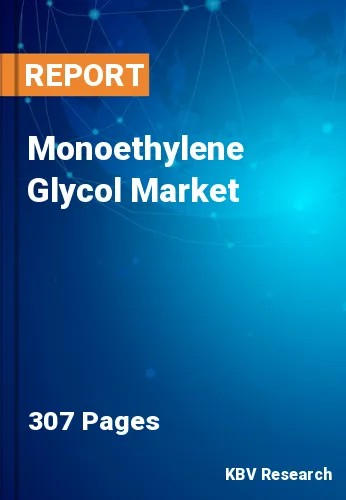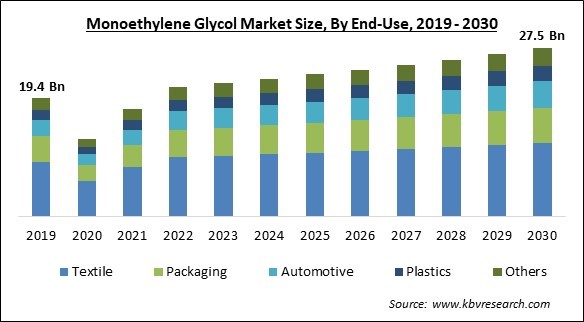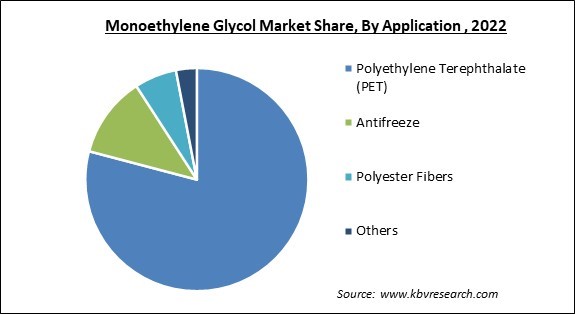
The Global Monoethylene Glycol Market size is expected to reach $27.5 billion by 2030, rising at a market growth of 3.4% CAGR during the forecast period. In the year 2022, the market attained a volume of 27,223.9 Kilo Tonnes, experiencing a growth of 2.8% (2019-2022).
As the automotive industry grows, so does the demand for MEG-based antifreeze and coolants. MEG is a key component in producing antifreeze and engine coolant formulations. Hence, automotive segment would generate approximately 1/4th share of the market by 2030. These fluids are essential for maintaining the proper operating temperature of automotive engines, preventing them from freezing in cold temperatures and overheating in high temperatures. The automotive industry has expanded globally, driven by increasing urbanization, rising disposable incomes, and transportation needs. Increased MEG usage results from growing passenger and commercial vehicle production in emerging markets. Some of the factors impacting the market are expansion of packaging industry, high potential for the growth of bio-based MEG, and shifting costs of raw materials.

MEG is used to produce PET (polyethylene terephthalate) resin, which is widely used for packaging applications, such as bottles for beverages and food products. Increased consumer demand for packaged goods and beverages drives MEG demand. PET resin, derived from MEG, is commonly used to produce bottles, containers, and packaging materials for various industries, including personal care products, food and beverages, pharmaceuticals, and more. The growth of these sectors directly drives demand for PET and, consequently, MEG. PET containers are used for packaging pharmaceuticals, vitamins, and healthcare products. The pharmaceutical and healthcare industries’ expansion contributes to the demand for MEG-based packaging materials. The expansion of the packaging industry, driven by factors such as consumer preferences, e-commerce, sustainability initiatives, and economic growth, plays a crucial role in uplifting the market. Additionally, Bio-based MEG production typically has a lower carbon footprint than conventional MEG production, which relies on fossil fuels. This reduction in greenhouse gas emissions aligns with global efforts to combat climate change. Consumers are increasingly seeking sustainable and eco-friendly products. Bio-based MEG produce sustainable materials, such as bio-based PET, which appeals to environmentally conscious consumers. Advances in biotechnology and bioengineering have improved the efficiency of bio-based chemical production processes, making them more cost-effective and scalable. As technology advances, bio-based MEG is expected to become more competitive and widely adopted in various industries, contributing to the overall growth and diversification of the market.
However, sudden spikes in raw material prices disrupt the supply chain as manufacturers struggle to secure a consistent and affordable ethylene supply. This led to production delays and increased lead times. Long-term supply agreements and contracts lock in prices for ethylene and other raw materials. However, when market prices fluctuate significantly, these agreements become less favorable for one party, potentially leading to renegotiations or disputes. Rapid changes in raw material prices leads demand-supply imbalances in the market. Manufacturers reduce or increase production in response to changing costs, which affect the availability of MEG for consumers.
By application, the market is categorized into polyethylene terephthalate (PET), polyester fibers, antifreeze, and others. In 2022, the polyethylene terephthalate (PET) segment held the highest revenue share in the market. PET is a synthetic polymer primarily used to produce plastic bottles and containers for beverages, food, personal care products, and more. Most PET production involves the polymerization of MEG with terephthalic acid (or its dimethyl ester, dimethyl terephthalate, DMT). The market and the PET demand are interconnected. Changes in demand for PET products, such as PET bottles for beverages or polyester fibers for textiles, influence the demand for MEG. Conversely, fluctuations in MEG prices or availability affect the cost and supply of PET resin. The demand for PET has been growing steadily due to its versatile applications, especially in the packaging industry. The beverage and food sectors, in particular, are significant consumers of PET bottles. Emerging economies with expanding consumer markets have driven the demand for PET.

Based on end-use, the market is classified into packaging, textile, automotive, plastics, and others. In 2022, the packaging segment witnessed a substantial revenue share in the market. MEG is also used in the production of PET containers for food packaging. PET containers are used for packaging various food products, including sauces, condiments, salad dressings, and more. As consumer preferences shift towards packaged and ready-to-eat foods, the demand for MEG-based packaging materials increases. The demand for packaging materials to ship products to customers has grown due to the expansion of e-commerce. PET bottles and containers are used for packaging various items bought online, from beverages to personal care products. The e-commerce boom contributes to higher MEG consumption.
| Report Attribute | Details |
|---|---|
| Market size value in 2022 | USD 21.1 Billion |
| Market size forecast in 2030 | USD 27.5 Billion |
| Base Year | 2022 |
| Historical Period | 2019 to 2021 |
| Forecast Period | 2023 to 2030 |
| Revenue Growth Rate | CAGR of 3.4% from 2023 to 2030 |
| Number of Pages | 307 |
| Number of Table | 570 |
| Quantitative Data | Volume in Kilo Tonnes, Revenue in USD million, and CAGR from 2019 to 2030 |
| Report coverage | Market Trends, Revenue Estimation and Forecast, Segmentation Analysis, Regional and Country Breakdown, Companies Strategic Developments, Company Profiling |
| Segments covered | End-use, Application, Region |
| Country scope | US, Canada, Mexico, Germany, UK, France, Russia, Spain, Italy, China, Japan, India, South Korea, Singapore, Malaysia, Brazil, Argentina, UAE, Saudi Arabia, South Africa, Nigeria |
| Growth Drivers |
|
| Restraints |
|
Region-wise, the market is analysed across North America, Europe, Asia Pacific, and LAMEA. In 2022, the Asia Pacific region led the market by generating the highest revenue share. The Asia-Pacific region, particularly countries like China and India, has witnessed rapid industrialization and economic growth. This growth has driven demand for various industrial products, including textiles, automotive components, packaging materials, and more, all rely on MEG and have become a significant hub for automotive manufacturing and sales. The production of vehicles, including passenger and commercial vehicles, has surged in countries like China and India. MEG is used in automotive antifreeze and coolant formulations, supporting the growth of the automotive sector.
Free Valuable Insights: Global Monoethylene Glycol Market size to reach USD 27.5 Billion by 2030
The market research report covers the analysis of key stake holders of the market. Key companies profiled in the report include Shell plc, LyondellBasell N.V., India Glycols Limited, SABIC, UPM Biochemicals, Kimia Pars Shayankar Co., Arham Petrochem Private Limited, Indian Oil Corporation Ltd., Pon Pure Chemicals Group, and ACURO ORGANICS LIMITED.
By End-Use (Volume, Kio Tonnes, USD Million, 2019-2030)
By Application (Volume, Kio Tonnes, USD Million, 2019-2030)
By Geography (Volume, Kio Tonnes, USD Million, 2019-2030)
The Market size is projected to reach USD 27.5 billion by 2030.
High potential for the growth of bio-based MEG are driving the Market in coming years, however, Shifting costs of raw materials restraints the growth of the Market.
Shell plc, LyondellBasell N.V., India Glycols Limited, SABIC, UPM Biochemicals, Kimia Pars Shayankar Co., Arham Petrochem Private Limited, Indian Oil Corporation Ltd., Pon Pure Chemicals Group, and ACURO ORGANICS LIMITED.
In the year 2022, the market attained a volume of 27,223.9 Kilo Tonnes, experiencing a growth of 2.8% (2019-2022).
The Textile segment is leading the Market by End-Use in 2022, thereby achieving a market value of $11.9 billion by 2030.
The Asia Pacific region dominated the Market by Region in 2022, and would continue to be a dominant market till 2030; thereby, achieving a market value of $15.2 billion by 2030.
Our team of dedicated experts can provide you with attractive expansion opportunities for your business.
